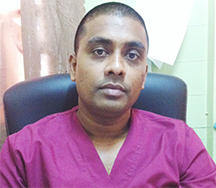With some cases of Chikungunya fever being detected in Region Six, health officials in Region Five have commenced a fogging exercise.
Regional Health Officer (RHO) Dr Gavin Persaud told Stabroek News that the team that was mobilized concentrated first on the West Bank Berbice area.
He said while there were no reported cases in the region as yet, blood samples had been taken on Wednesday from persons bearing some of the symptoms such as high fever.

The samples were sent to National Reference Lab in Georgetown and would be forwarded to Trinidad. The results are expected to be available within one week.
He said some persons have become alarmed and have visited the hospitals for samples to be taken when it was not necessary for them to do so.
Before the fogging commenced, announcements were made in the communities for residents to take precautionary measures such as covering food and keeping children indoors.
Notices were also places on television while all of the Neighbourhood Demo-cratic Councils (NDCs) were summoned to get involved in creating awareness.
Persaud said he hoped the region would achieve some success with the effort which was being conducted with the assistance of the Vector Control Services, headed by Dr Reyaud Rahman.
A Malathion mixture has been used in the exercise and although it is very lethal to the mosquitoes, Dr Persaud said the poison it is not harmful to humans.
Persaud, Regional Education Officer Owen Pollard and Regional Executive Officer Ashford Ambedkar also met a pest control agent to take care of all government buildings, especially the health centres, the two hospitals along with all 70 schools in the region.
There were also plans to start spraying the schools last weekend using Fendona, a pyrethroid insecticide, which is sometimes used in impregnable mosquito nets and has a residual effect. This would help to prevent mosquitoes from breeding in the schools.
Persaud said that while it is important to control the vector they are also concentrating on getting rid of breeding grounds for mosquitoes, such as stagnant water in old containers.
The virus is spread by the aedes aegypti mosquito and causes severe joint pains, headaches, spiking fevers, muscle pains and vomiting, mimicking symptoms of dengue fever.
According to the World Health Organisation, “Chikungunya is characterized by an abrupt onset of fever frequently accompanied by joint pain. Other common signs and symptoms include muscle pain, headache, nausea, fatigue and rash. The joint pain is often very debilitating, but usually lasts for a few days or may be prolonged to weeks.
Most patients recover fully, but in some cases joint pain may persist for several months, or even years. Occasional cases of eye, neurological and heart complications have been reported, as well as gastrointestinal complaints.”





